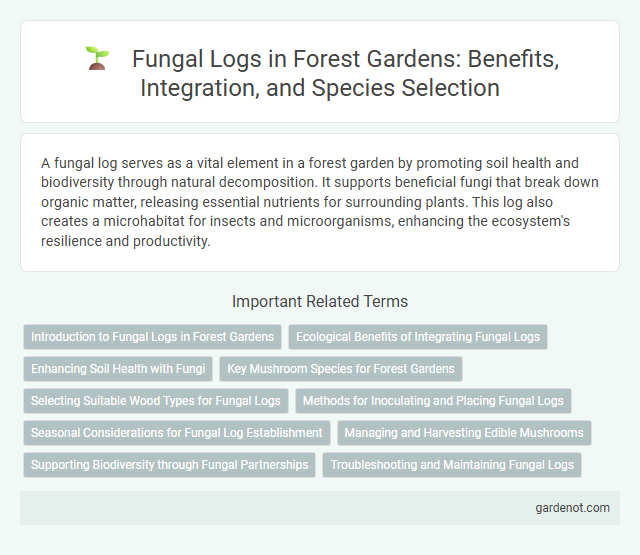A fungal log serves as a vital element in a forest garden by promoting soil health and biodiversity through natural decomposition. It supports beneficial fungi that break down organic matter, releasing essential nutrients for surrounding plants. This log also creates a microhabitat for insects and microorganisms, enhancing the ecosystem's resilience and productivity.
Introduction to Fungal Logs in Forest Gardens
Fungal logs are a vital component in forest gardens, serving as natural decomposers that enrich soil fertility by breaking down woody material and releasing essential nutrients. Inoculating logs with mycelium from mushrooms such as shiitake or oyster promotes biodiversity by creating habitats for beneficial fungi and microorganisms. This sustainable practice enhances ecosystem health, supports plant growth, and contributes to the cyclical nutrient flow within forest garden systems.
Ecological Benefits of Integrating Fungal Logs
Fungal logs enhance soil fertility by breaking down organic matter and releasing vital nutrients, promoting healthier plant growth in forest gardens. They support biodiversity by providing habitat and food sources for beneficial microorganisms, insects, and wildlife. Integrating fungal logs helps maintain ecosystem balance, improves soil structure, and accelerates nutrient cycling essential for sustainable forest garden management.
Enhancing Soil Health with Fungi
Fungal logs play a crucial role in forest garden ecosystems by enhancing soil health through mycorrhizal networks that improve nutrient uptake and water retention. These logs decompose organic matter, enriching the soil with essential minerals and supporting beneficial microbes that promote plant growth. Integrating fungal logs into forest gardens fosters a balanced soil microbiome, leading to increased biodiversity and resilient plant communities.
Key Mushroom Species for Forest Gardens
Fungal logs support key mushroom species such as Shiitake (Lentinula edodes), Oyster (Pleurotus ostreatus), and Lion's Mane (Hericium erinaceus), which thrive on hardwood substrates in forest gardens. These species enhance soil health by decomposing organic matter and promoting nutrient cycling essential for plant growth. Incorporating fungal logs in forest gardens increases biodiversity, supports mycorrhizal networks, and contributes to sustainable ecosystem functioning.
Selecting Suitable Wood Types for Fungal Logs
Selecting suitable wood types for fungal logs is crucial for successful mushroom cultivation in a forest garden. Hardwoods such as oak, maple, and beech provide dense nutrients that support robust fungal growth, while avoiding softwoods like pine or cedar prevents contamination and resin interference. Properly aged and disease-free logs ensure optimal colonization and high yields of edible or medicinal fungi.
Methods for Inoculating and Placing Fungal Logs
Fungal logs are inoculated using methods such as drilling holes into hardwood logs, inserting spawn plugs or sawdust spawn, and sealing with wax to promote mushroom mycelium growth. Placement of fungal logs in shaded, moist environments like under canopy trees or mulch beds ensures optimal humidity and temperature for mycelial colonization. Proper orientation, such as placing logs horizontally or slightly inclined, allows for effective water retention and air circulation, enhancing mushroom fruiting success.
Seasonal Considerations for Fungal Log Establishment
Fungal log establishment thrives in cool, moist conditions typically found during early spring and late fall when temperatures range between 50-70degF (10-21degC). High humidity and consistent moisture levels are critical for mycelium colonization, while avoiding extreme heat or drought prevents fungal stress. Selecting dormant hardwood logs inoculated soon after felling enhances successful seasonal fungal growth in forest garden ecosystems.
Managing and Harvesting Edible Mushrooms
Managing a fungal log involves maintaining optimal moisture levels and positioning it in shaded, humid environments to encourage growth of edible mushrooms such as oyster or shiitake varieties. Regular monitoring for signs of contamination and prompt removal of competing fungi ensures healthy colonization by desired mushroom species. Harvesting should occur when mushroom caps fully expand but before spore release, maximizing flavor and nutritional value while sustaining future yields.
Supporting Biodiversity through Fungal Partnerships
Fungal logs play a crucial role in forest gardens by fostering symbiotic relationships between fungi and plants, enhancing nutrient cycling and soil health. These decomposing logs provide habitat for diverse fungal species, which in turn support mycorrhizal networks essential for plant root communication and nutrient absorption. Incorporating fungal logs increases biodiversity by promoting beneficial fungi that aid in pest resistance and ecosystem stability.
Troubleshooting and Maintaining Fungal Logs
Fungal log maintenance involves regularly monitoring moisture levels to prevent drying out or waterlogging, both of which hinder mushroom growth. Troubleshooting common issues includes identifying contamination by unwanted molds or pests and removing affected sections promptly to protect healthy mycelium. Ensuring optimal shade and airflow supports fungal development and encourages robust fruiting within forest garden ecosystems.
Fungal log Infographic

 gardenot.com
gardenot.com